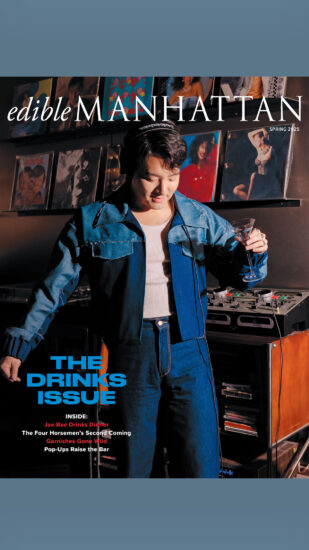
Today and Sunday on NY1, we interview Brooklyn chef Ronna Welsh, who runs cooking workshops and caters meals or events through her company Purple Kale Kitchenworks. We grew smitten with Welsh’s approach — which she calls “2 minutes to dinner” — back when we were doing a story on city cooking classes with a seasonal, local and sustainable focus last year. Welsh spent years in professional kitchens like Savoy, and she now uses techniques for managing the line to feed her own family, and its what she now teaches her workshop participants.
Unlike home cooks, professional chefs don’t go out with a recipe in hand to shop for ingredients they likely can’t find right before they want to sit down and eat. Instead, they often start by buying what’s freshest at the market or what looks good at a shop. Then once they get those ingredients back into their kitchens, they cut, dice or preserve them in some way so they last longer and are also ready to be incorporated into a dish.
A restaurant kitchen is usually a forest of those little plastic tubs with tape labels, full of diced green onions, lemon aioli, chicken stock, cooked quinoa, some kind of chutney or vinaigrette or thick sauce that can be added straight, blended with oil or water or mixed in to provide flavor in all kinds of ways and all kinds of dishes.
It’s part of a process the French call mise en place. “The term mis en place,” says Welsh, refers to everything in its place. … What it is is a system that frontloads the work of preparing raw ingredients to a certain point so that when an order comes in from a customer, the chef is able to assemble that meal with efficiency and the utmost quality.” In Welsh’s workshops, she teaches customers how to apply that idea to their kitchens.
“The two-minutes-to-dinner system comes in at the point where people come home from a long day and they open up the refrigerator and then they say there’s nothing to eat,” Welsh says, “and what I try to do is teach them how to set up a system of components very much like this where they have individually prepared ingredients taken to a holding point. A holding point is a point at which an ingredient is most versatile and useful.”
For example, Welsh likes to make a thick vinaigrette made of pureed, reconstituted raisins and capers and mustard that hasn’t yet been blended with oil. “It’s a actually a base of a vinaigrette,” she explains, “…and the idea behind this is I can [use it to] make sauces, or spreads or dressings.”
Welsh’s fridge is full of ingredients at various stages of preparedness just like this: Depending on the season or her mood, she’ll have a tub of blanched farmers’ market peas, one of cooked and salted whole new potatoes, some chicken stock, some onion jam, some washed dandelion greens, the bits of meat and jus leftover from a pan of roast lamb, some cooked quinoa stored in its cooking water, some blanched fiddlehead ferns or some flavored butters or pureed rhubarb. Then she can use those ingredients in all kinds of ways, depending on what she wants to eat. She also notes that it’s important to label things, so you’ll use them, and that she can eat much of those foods right out of the container. (“I’m well aware,” she adds, “that some peas and some herb butter equals dinner.”)
Take the onion jam, for example. “It’s a kind of savory compote of onions cooked way way down for a really long time with stock and vinegar and a little bit of salt and a little bit of sugar, and this is something I use to provide deep, deep flavor to a lot of dishes,” says Welsh. “So sometimes I’ll use onion jam in a really obvious way to spread on top of toasts for example with a slice of cheese, and sometimes I’ll puree it into a soup so it provides that richness without it being an obvious addition.”
Or consider those potatoes, which Welsh roasted covered in salt, the same way you’d do for fish: “I can actually take this just roast them, serve them as roasted potatoes. I could cut them up and put them into broth for soup, I could mash them. I also have a little tub of aioli, which is a garlicky mayonnaise, and I might make a kind of a potato salad. In this case,” says Welsh of her dinner plans, “I am just going to take these potatoes and some capers and this raisin vinaigrette and just make a nice side dish.”
The whole point is to begin to think of making inner in a different way: Keep a few things on hand you can cook with quickly, and then work with what you have when you get home. “One of the things that’s great when you start with an ingredient driven-approach, which is what this whole system is,” says Welsh, “is that you structure your meals not around what I’m having for dinner but what do I have, and you go from there.”



